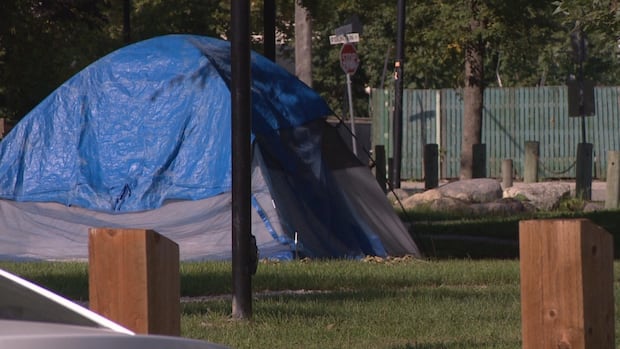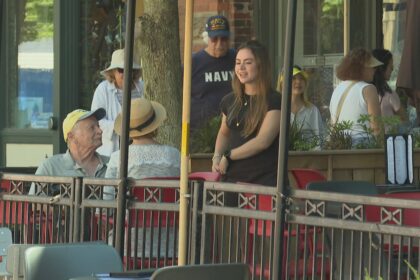ManitobaAs Winnipeg city councillors eye new restrictions on homeless encampments, some say limiting them to a specific area could be a better solution.Kelowna’s designated site model better at helping people find homes: project leaderOzten Shebahkeget · CBC News · Posted: Sep 14, 2025 7:00 AM EDT | Last Updated: 2 hours agoLast week, Winnipeg city council’s community services committee unanimously approved a motion that bans encampments in some areas, including near playgrounds, pools, schools and daycares. (CBC)As Winnipeg city councillors eye new restrictions on homeless encampments, some say limiting them to a specific area could be a better solution.On Monday, Winnipeg city council’s community services committee unanimously approved a motion that bans encampments in some areas — including near playgrounds, pools, schools or daycares — and calls for enforcement of the new rules during the day.The motion still must go to the executive policy committee before a final vote by council later this month.Shane Popeil, who’s been living in Winnipeg encampments since the COVID-19 pandemic, says he supports the motion, but doesn’t like the idea of making people pack up and move during the day.”It would kind of be chaotic,” he told CBC News outside of his Point Douglas encampment on Tuesday.Shane Popiel, who has been living in encampments since the COVID-19 pandemic, says there will always be homeless people who refuse shelters and live outside. (CBC)Living in an encampment has its highs and lows, Popeil says, but describes himself as a free spirit who likes being outside. He says that there will always be homeless people who refuse shelters and live outside.”Some people just don’t want to be in shelters,” he said. “There’s too much drama, and the theft is just unbelievable. Maybe they can come to a solution where they have an area that’s designated for [encampments].”Coun. Jeff Browaty (North Kildonan) is one of the city councillors pushing to pass the motion, but he agrees that forcing people out of encampments during the day might not be feasible.”It’s not realistic that every encampment is going to go away during the day, but it allows, you know, lines to be drawn in the sand,” he said.Browaty doesn’t accept the idea of making a designated space for homeless encampments.”It’s not a humane way for people to live,” he said. “If people have really no mental capacity, no physical capacity to provide some value to society, then that’s the type of place where, yes, the state does need to step in and provide some level of housing.”Coun. Jeff Browaty (North Kildonan) says his goal is to get rid of all encampments in the city. (Gary Solilak/CBC)If the motion were to pass city council, Browaty says, he doesn’t see the city immediately ordering every homeless encampment to be taken down immediately. However, the city might instead pick and choose which encampments have run their course.”My goal would be to eliminate all encampments, but I don’t think that’s going to happen overnight.”Kelowna modelThe project lead of a designated encampment site in Kelowna, B.C., says they’ve seen success after making space for homeless encampments four years ago.In May 2021, the city in the B.C. Interior set up what it calls an “outdoor sheltering site” on the Rail Trail where people could sleep in tents between 6 p.m. and 9 a.m. every day.The main purpose of the site was to discourage people from camping in city parks and other public spaces. The site is a few blocks away from homes, and is near a shelter and a couple of breweries.The City of Kelowna’s outdoor sheltering site, pictured in 2022, might serve as a model for Winnipeg. (Chris Walker/CBC)Nick Bonnet, who leads the city’s encampment response unit, says “there never will be a perfect space” for designated encampments, but Kelowna’s approach was to balance the needs of the community and the vulnerable.”We found that this space did achieve that balance in that it was within walking distance to essential services,” he said Thursday.He sees the designated site model as a calmer and more effective method of helping homeless people find housing. As of Thursday, he said, the city was able to house six people from the site that week alone.”We find that there’s an important distinction and need in the community to have not only just that overnight space, but also a landing area that offers some stability,” he said.”By having that designated space where maybe you don’t have to think about where you’re going to go with your belongings that day, it gives that person the opportunity to to think through what’s next and what they want.”His advice to Winnipeg is to approach a designated site model as a team that would include social service organizations, the provincial government and community members, because municipalities can’t do it all on their own.”You’re able to focus services … create natural and desirable communication lines, and to just continue to work with the community,” he said.With files from Gavin Axelrod and Marshal Hodgins
Monday, 22 Dec 2025
Canada – The Illusion
Search
Have an existing account?
Sign In
© 2022 Foxiz News Network. Ruby Design Company. All Rights Reserved.
You May also Like
- More News:
- history
- Standing Bear Network
- John Gonzalez
- ᐊᔭᐦᑊ ayahp — It happened
- Creation
- Beneath the Water
- Olympic gold medal
- Jim Thorpe
- type O blood
- the bringer of life
- Raven
- Wás’agi
- NoiseCat
- 'Sugarcane'
- The rivers still sing
- ᑲᓂᐸᐏᐟ ᒪᐢᑿ
- ᐅᑳᐤ okâw — We remember
- ᐊᓂᓈᐯᐃᐧᐣ aninâpêwin — Truth
- This is what it means to be human.
- Nokoma











